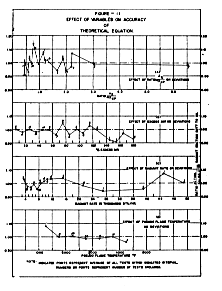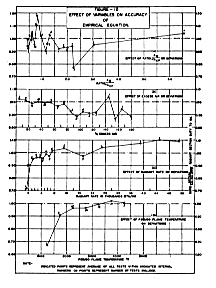|
*In a bank of three or more rows of tubes a = 1.0, and Acp = aAcp'
It may be seen from Table III that in practically every case the equation
presented in this paper correlates the test data better than the empirical
equation even though the furnace tests used to determine the constants of the
empirical equation are included in the present data. The maximum deviation has
been reduced from 335 to 16%. These facts are perhaps best illustrated by
Figures Nos. 9 and 10, which show the spread of the data using both methods of
correlation. Inasmuch as the data represent plant tests, it is suspected that
the larger deviations may be due to inaccuracies in the data and not to any
fundamental fault in the radiant equation. It is significant that using the
theoretical equation the greatest deviations are not confined to any one furnace
but seem to be well distributed. Again, furnace No. 4, the worst case, shows
deviations of -11% and -12% and +14%, indicating that the data on this one
furnace are probably less reliable than the average. Actually, the temperature
of the gases leaving the radiant section of this furnace was determined at only
two points instead of by a complete traverse. Since in many cases it is
difficult to judge exactly the accuracy of the plant data, no attempt has been
made to segregate and give more weight to the better data. The number of tests
available for this study is hardly large enough for a rigid statistical
analysis, but for some generalizations are justified. For instance, considering
the data in their entirety, Figures Nos. 10 and 12(A) indicate that the
deviations between the observed and the calculated heat absorption occur in a
random manner and are not peculiar to any one fiurnace, even though the ratio of
effective refractory to effective cold surface, ( Ar / aAcp ), varied fourteen-fold for the
furnaces investigated.
Figure 11 (B) (C) (D) and Figure 12 (B) (C) (D) are given in order to permit
visualizing the effect of some of the variables on the results obtained by the
two correlations.
The effect of excess air is shown in Figures 11 (B) and 12 (B). It should be
remembered that although the percentage of excess air varied less than 10% to
more than 170%, other factors may likewise have been varying at the same time.
In general, the empirical equation appears to predict correctly the heat
absorption by the oil in the radiant section in the excess air range from 10% to
80%, the more usual commercial range. Above 80% it predicts heat absorptions
which are 10% to 13% too high. Over this range, 10% to 170%, the theoretical
equation shows no significant trend. As previously pointed out, the use of an
air-fuel ratio is open to criticism and the trend may be due to this factor.
Figures 11 (C) and 12 (C) classify the data according to average radiant rate
based on circumferential tube surface, B.t.u. per hour per sq. ft. In those
furnaces with a double row of radiant tubes, the rate has been taken as the
average first row rate. Here, again, the theoretical equation shows no
significant trend over the range 3,000 to 51,000 B.t.u. per hour per sq. ft. The
empirical equation shows signs of breaking down at rates below 4,000 and
predicts radiant section heat absorption 10% in excess of the true figure at
that point. Only two tests are available at rates between 3,000 and 4,000 but
they confirm the trend and indicate that the heat absorbed by the oil, as
calculated by the empirical equation, may be almost 40% high in this range.
Figures 11 (D) and 12 (D) give another indication of the range of the furnace
data, but have significance only in that they give an indication of the
theoretical flame temperature. These figures show that over the wide range of
t'f ' the pseudo-theoretical flame temperature, the deviations
have no definite trend. It is obvious, therefore, that petroleum heaters can be
designed by means of the new equation for fuels of widely different heating
values as a low pseudo-flame temperature may mean either a fuel of low grade, or
a high heating value fuel degraded with excess air or recirculated inert gas.
Since most of these tests have been made with very similar fuels, the trend
shown in Figure 11 (D) is probably due to the composite effect of rate and
excess air discussed above.
 |
 |
<--
page 1 -- page 3 -->
|
|



